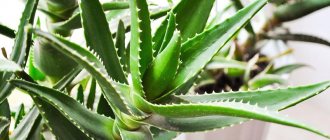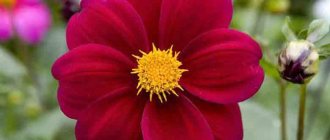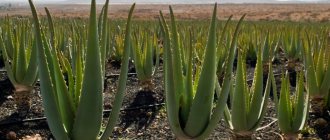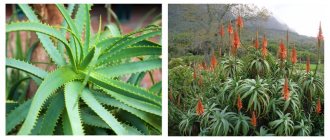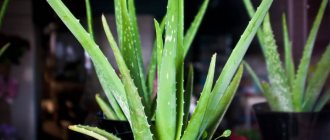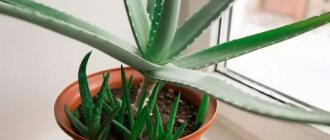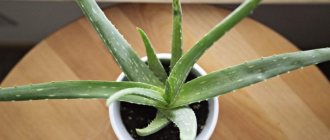Rules for transplanting aloe
You need to know how to properly transplant aloe so that the plant feels comfortable. To do this, take into account the size of the plant, its age and other nuances.
How to transplant an adult plant into another pot?
A novice owner should familiarize himself with the rules on how to transplant aloe into another pot so that it quickly takes root. To begin, select a suitable pot and prepare the substrate. If the rhizome grows to the sides, you will need a wider container; if it grows downwards, a deeper one. Next you need to follow a few simple steps:
- pour a small earthen pillow into the new pot;
- carefully remove the plant from the old container, being careful not to damage the roots;
- place it in a new pot and add soil to the sides.
You may need to add some soil after a few days as it compacts. In a new container, the plant is left in the shade for a week, watered only after 5 days. Then it is transferred to a well-lit windowsill or balcony.
How to separate and plant a shoot?
The most common way of propagating aloe is by shoots, or babies. They appear every year under the mother bush and already have their own roots. You need to know a few nuances on how to transplant an aloe shoot so as not to harm the adult plant:
- a small bush is carefully dug out of the ground so as not to damage the roots;
- immediately transplant it into a separate pot;
- Water the plant moderately every few days.
This is the easiest way to transplant aloe. In this way, the plant can reproduce all year round, but it is better to wait until the warm season. This plant can produce a large number of babies per season. Many owners complain that their flowers multiply too intensively, and their pots take up all the free surfaces.
Transplantation by cuttings
Aloe can propagate by cuttings. They are shoots that extend from the main stem. The procedure is simple and can be carried out at any time of the year:
- the process is cut with a knife as close to its base as possible;
- the cut needs to be dried before planting, so the sprout is left in the shade for 5 days;
- without waiting for the roots to appear, the cuttings must be planted in the ground to a depth of several centimeters;
- The plant is watered immediately after planting, and then after it has taken root.
We recommend: Aloe Vera and Agave - beneficial properties and differences
You can plant several cuttings at the same time in one large container. In this case, the distance between flowers should be at least 5 cm.
Transplantation without roots
If the flower grows too tall, you can separate the top and form a separate plant. The lower leaves are immediately used to obtain juice or gel, which are then added to cosmetics and medicines. The transplant procedure is very simple:
- the top with 6-7 leaves is cut off with a knife;
- the shoot is placed in a jar of water and waited until it takes root;
- the plant is planted in a pot with a suitable substrate.
The method of replanting aloe without roots is suitable for large adult plants. The leaves become suitable for medicinal purposes at 3-4 years of age, then they are cut off. As a result, the flower turns out to be tall, and the leaves are located only at its top.
Choosing a pot and soil
Agave will grow well in a large pot. Once a year it is recommended to transplant it into a new container, which will be 1/5 larger than the previous one. When aloe reaches the age of 4 years, it is enough to replant it once every 2 years, after a few years - every 3 years.
For aloe, a universal primer or one sold under the name “for succulents” is suitable. It can also be prepared at home:
- 1 part sand;
- 1 part each of humus and leaf soil;
- 2 parts turf soil.
The flower is unpretentious to the composition of the soil. It will grow in any conditions, even with insufficient watering. The only condition is that he prefers well-lit areas. There are no special fertilizers for succulents. Because they grow in dry climates, they will do well even in regular store-bought all-purpose soil. If desired, you can add some organic fertilizers to the substrate:
- humus;
- Activated carbon;
- wood ash.
Young flowers that have just taken root and are beginning to grow may need feeding. For an adult aloe, it is enough to feed the soil with fertilizers during transplantation. A fully formed bush is transplanted into a new container every few years, and it is fertilized at the same frequency.
We recommend: Aloe spinosa - care and beneficial properties
Transplant methods
Aloe propagates easily:
- By transplanting part of the adult color;
- Jigging of the shoot;
- Parts of green leaves;
- Seeds.
Each method has its own little tricks.
Transplanting an adult plant
You need to replant an old aloe in the following cases: Buying a flower in a store. If the flower has “outgrown” the size of the pot. Diseases have appeared in the soil or pests have infested. Stages of transplanting a whole plant:
- Water a day or two before transplanting.
- Free from the old container. The earth is slightly shaken off, old rotten roots are removed. If the transplant is caused by the presence of pests or diseases, the roots are completely washed off the ground.
- 2-3 cm of finished soil is poured onto the drainage layer.
- The plant is placed in the center of the pot. The roots should not bend. The stem is placed 2-3 cm below the edge of the planting container.
- The roots are evenly covered with earth, lightly compacted.
- Watering is carried out strictly at the root. Moisture should not get on the rosettes of leaves and cause rotting of the weak plant after replanting.
- Protect from direct sunlight for 3-5 days.
Separation and transplantation of the shoot
The shoots grown from the root are suitable for jigging. You can plant an aloe baby when the small plant has reached 5-10 cm in height and has produced 3-4 leaves. Two ways to take a shoot from aloe:
The plant is removed from the pot and the soil is shaken off. In this case, with a sharp knife it is easy to separate all the shoots along with the roots and the adult plant
Small plants are transplanted into separate pots or into a “school” for growing. Using a narrow spatula, carefully separate the shoots, trying not to damage the roots. The adult flower is not removed, leaving it to grow in its original place.
Without root
Aloe successfully reproduces from parts of the plant without roots:
- Cuttings;
- Leaves;
- The tops of woody stems
Aloe cuttings are young shoots that grow from the base, side stem or top of the plant.
Cuttings or parts of leaves are cut with a sharp knife closer to the mother plant. After treating the cut site with activated carbon, the planting material is removed to a dark, cool place to allow the wound to heal. A leaf or cutting is planted in damp, washed sand. In two weeks the roots will appear.
After the plant has come to life and started to grow, it is transplanted to a permanent place. A new plant is obtained using the “rootless” method from the tops of “wooden” stems. To do this, cut off the “top” 2-3 cm below the leaves. The cut part is placed in a container with water. After the roots appear, the top is transplanted into a pot with soil.
Step-by-step procedure for moving a flower into open ground
- The area where you are transplanting aloe is cleared of weeds.
- A hole is dug into which a specially prepared substrate with sand is added.
- Three days before transplanting, the plant is freed from the pot, and its roots are cleaned and dried during this time.
- Then the aloe is transplanted into a prepared hole with a substrate and surrounded with stones to avoid clogging with weeds.
Peculiarities:
- The place for transplanting into open ground should be illuminated, but without constant access to direct sunlight.
- In rainy weather, you need to make sure that the plant does not get wet, otherwise it may rot.
- For the winter, aloe is wrapped in film and not watered.
Preparation
Rooting a plant at home will require preliminary preparation of containers for planting. Its size should be selected depending on the age of the crop: for a young flower you will need a large pot; for aloe with sprouts, you can only replace the soil, and also plant the “babies” in separate pots.
To cultivate succulents, it is recommended to use plastic or ceramic containers. In polymer pots, the plant will develop evenly, but in such a container it is necessary to ensure that the moisture does not stagnate. As for pots made of ceramics, this material is capable of allowing air to pass through, which will facilitate the natural evaporation of excess moisture, as well as normalization of temperature. This will make it easier for the grower to care for his plant in the future.
Before rooting the culture into the purchased container, it must be thoroughly washed and dried.
Proper preparation of the soil for the crop will help reduce stress for the plant; it is worth rooting aloe in a substrate that is as identical in composition as the old soil. The soil can be purchased at the store or prepared with your own hands. In the first case, the substrate must be intended for growing succulents and cacti. If you plan to prepare the soil yourself, then certain recommendations should be followed in this matter. The ground should be:
- nutritious and light;
- with neutral acidity.
There are several options for preparing the substrate at home:
- the soil may consist of sand, leaf and clay turf soil, taken in equal proportions, with the addition of half of the peat;
- sheet soil, coarse sand and charcoal.
In addition to the pot and soil mixture, it is also necessary to prepare the crop itself for replanting. In this case, a few days before the planned rooting of the plant in a new place, it needs to be well moistened. This will make it easier and with minimal damage to later remove the aloe from the old pot.
About the need for a transplant or who needs it
Aloe roots develop slowly, but replanting cannot be delayed. There is such a thing as the removal of nutrients from the soil by a plant. The coefficient of mineral removal from aloe is high, which cannot be said about nitrogen, which desert dwellers have little need for. Applying fertilizers will not correct the situation: the humic and enzymatic components of the soil are lost, which cannot be replenished. The soil becomes as light as dust and crusts over after watering. And the tap-shaped root grows, and the lobe-shaped ones begin to protrude from the pot. It is urgently time to correct the situation: replant the aloe, change the soil mixture.
Transplant time is spring or summer. If the roots have grown slightly or a voluminous plant is difficult to replant, simply replace part of the soil.
Requirements for soil mixture
The soil should be light and loose, allowing the roots to access air. The composition is a mixture of clay-turf soil and forest deciduous soil with sand in equal proportions. The addition of charcoal or peat mixture should not exceed a fifth of the soil.
Small stones are placed at the bottom of the pot for a drainage layer, which helps remove excess moisture from the pot. These are fine gravel, sea pebbles, expanded clay, and sawdust.
Step by step transplant instructions:
- on the eve of replanting, the flower is watered abundantly for easy release from a cramped pot and separation of salt-depleted soil from the root system;
- the agave is carefully removed from the flowerpot, tilted over the prepared place on the table to spread the soil and further divide the bush into individual plants;
- fragile fleshy leaves require careful handling when planting in a new place for further growth;
- the soil around the root system should be held in a lump, facilitating faster rooting in a new location;
- the roots are inspected, rotten ones are removed and the plants are sorted according to the size of suitable flowerpots for each succulent;
- prepare a drainage layer along the bottom with a thickness of 5 to 10 cm, depending on the size of the new pot, consisting of fine gravel and sawdust.
- The separated aloe is placed on a small layer of soil mixture and covered with prepared soil to the edges of the flowerpot, slightly compacting the moistened soil;
- to retain moisture before aloe takes root, the top layer of soil is laid out with a layer of expanded clay stones;
- After transplantation, the succulent is removed to a shaded place for several days without watering.
Main reasons for changing the potty
Reasons for replanting a succulent:
- Many young shoots have formed that interfere with each other and the mother plant too. Planting is done by dividing the bush into separate independent shoots with good roots.
- If water is quickly absorbed into the soil, then the root system is distributed throughout the flowerpot and instantly absorbs the liquid. It's time to transplant the plant into a spacious flower pot.
- There is a noticeable tightness for the roots of the succulent, which has filled the entire space, that there is no access to the soil along the edge of the growing container and it is difficult to water the plant.
- A flower purchased in a store requires planting in a permanent place in prepared soil intended for succulent plants. The purchased pot contains soil mixture for transportation and is temporary. Contains pieces of foam plastic, broken brick, and shell rock as drainage material.
- Gradually, the soil is depleted due to an excess of salts, and the succulent slows down its growth, the lower leaves deteriorate and dry out. It is necessary to update the soil mixture and transplant the plant into another pot.
- Sometimes a transplant saves aloe from disease or decay. New soil gives the flower additional strength to recover. The paleness of the leaves or blackening from waterlogging of the roots is the reason for moving to another flowerpot and replacing the soil with a new one.
- The agave has aged and requires updating. Curved trunk, asymmetrical formation of the bush, unaesthetic appearance.
- Damage to succulent leaves by fungi, scale insects or spider mites. Separating intact young shoots and treating each plant individually can save aloe from complete infection and death.
A young plant is replanted annually; after reaching the age of 3–5 years, you can do it once every three years. Aloe does not like excess moisture, so it is necessary to arrange drainage from expanded clay and smooth river pebbles.
When the soil is compacted, the growth rate slows down, and a lack of air in the root system leads to yellowing or paleness of the flower leaves. The procedure of replanting an overgrown succulent is stressful for the mother plant, so it is left in a pot if possible, only the young shoots are separated, making room for the root system of the aloe tree. The soil mixture should be updated.
The correct selection of pot size affects the further development of succulent inflorescences. When replanting a plant, the roots should not reach the side walls of the flowerpot by a couple of centimeters, and the volume of the pot should be smaller relative to the size of the crown of the bush.
The succulent is not planted deep into the ground, leaving a couple of inches of the tree-like trunk above the surface.
Simple rules of care allow it to be grown by inexperienced amateurs who have purchased a medicinal plant for the home for the first time.
Further flower care
The plant moves to partial shade for a week or two. In a shaded position, the flower heals injuries and gets used to new conditions. Injuries during transplantation are always inevitable, even if the plant was transplanted very carefully.
Location and lighting
The plant needs a significant amount of sunlight. In spring, it is necessary for aloe to get used to intense sunlight. At lunchtime, it is enough to hang a small screen on the window. This technique avoids burns.
Aloe on a sunny windowsill
Important! In summer, during very intense heat, the plant must be hidden from the sun. It’s good if aloe grows on a balcony or terrace in summer
In these conditions, it must be hidden from the rain. Excess moisture causes the flower to rot.
It’s good if aloe grows on a balcony or terrace in summer. In these conditions, it must be hidden from the rain. Excess moisture causes the flower to rot.
In autumn, when daylight hours decrease, aloe needs additional lighting. A fluorescent lamp is suitable for this. It needs to be turned on as soon as the sun disappears below the horizon.
Temperature
The optimal temperature should not be higher than 30 degrees. In winter, you need to ensure that it does not fall below 12 degrees. Aloe does not withstand frost, so a sharp drop in temperature in winter rooms should not be allowed.
Humidity
The plant tolerates dry indoor air well. However, if dryness is combined with elevated temperatures, it needs to be watered more often and sprayed periodically. In winter, when the central heating is on, you should use humidifiers or place small containers of water near the pot.
The plant should not be allowed to develop in damp rooms. The root system and stems will suffer from this.
Watering
Watering is highly dependent on the ambient temperature. If in summer the temperature reaches 30 degrees, then the plant needs to be watered every other day, sometimes daily. In the cold season, the temperature can drop to 12 degrees, in which case aloe is watered once a week.
When growing, the soil is watered at the root, and not from above. Water that gets on the leaf rosette causes the stem to rot. The main criterion for the need for watering is complete drying of the soil.
An adult plant is fed no more than once every 3 weeks. The best would be a special fertilizer for cactus.
The soil
It is necessary to monitor the condition of the soil. If it turns sour, the bush urgently needs to be replanted. You need to purchase the substrate at flower shops - there are kits specially designed for succulent plants.
Important! Aloe needs the soil to always be loosened
Loosening should be done carefully so as not to damage the roots.
If the plant does not take root
There are several reasons why the plant does not take root:
- Inappropriate soil composition. You urgently need to replace it or prepare a mixture with the correct ratio of components. The best option is to purchase a ready-made mixture for succulent species.
- Poor quality planting material when transplanting cuttings. This happens if the cutting is taken from a large plant. In this case, the agave needs to be replanted again.
- Incorrect care. It is necessary to carefully follow the recommendations of gardeners and promptly eliminate even the smallest signs of the disease.
Diseases, pests
Agave can be affected by dry or gray rot. Diseases manifest themselves as drying or deformation of the leaves and rotting of the roots. If these signs are detected, the agave needs to be urgently transplanted.
Aloe can be affected by the following pests:
- Spider mite. It is difficult to notice due to its small size. The main sign is that the finest cobwebs appear on the leaves. The leaves turn pale and dry. At a late stage of the disease they become scarlet.
- Scale insects inhibit the process of photosynthesis. Red spots appear on the leaves.
- A sign of a mealybug is a coating of leaves.
Pests can be controlled using special antiparasitic drugs.
Aloe is an unpretentious, beautiful and useful plant. If you take good care of it, there will never be any problems with it. Its longevity will depend on proper transplantation.
Maintenance and care
Properly replanting your aloe vera is only one part of the job. It is very important to properly care for the plant in the future, especially in winter. A transplant at this time is already fraught with losses, especially if no further care is taken.
It is important to pay attention to the room temperature and lighting during the day. In order for the root system to quickly recover and adapt, the thermometer should show a temperature of about 20-23 °C. If the temperature is lower, development is delayed or stops completely.
Aloe vera needs long days of light during its regeneration period. To provide 14 hours of good lighting, a phytolamp is used, but ordinary fluorescent lamps are also suitable. They must be at a certain distance, approximately 25 cm above the plant.
When the plants show signs of growth, you can apply fertilizer in the form of a mineral complex. You can buy special fertilizers for succulents in the store. Too much of a nutrient is even more harmful than too little, so manage your intake carefully. Watering during the adaptation period should be moderate and kept to a minimum, especially if rot was noticed during transplantation.
If aloe does not take root, you need to find the reason and understand how to improve the situation.
When is the best time to do this?
The best period for rooting aloe in a new container will be spring; it is important to choose the right time so that the plant is just emerging from the dormant phase and has not yet begun to actively develop. If you have time to replant a succulent during this period, the active metabolism that accompanies the growing season will help the crop quickly adapt to new conditions and maintain its health.
This is especially true for the root system, which in any case will be disturbed and injured during the process of removing the plant from the old soil and rooting in a new container. Some gardeners transplant aloe in the summer, while simultaneously propagating the crop.
It would be better to refrain from such work in the autumn and winter, since at this time the succulent will already suffer from a lack of sunlight, which will weaken its immunity. In addition, the autumn-winter period is the resting phase for aloe. As a result, the flower will need much more time to adapt to new conditions.
Growing aloe at home
Thanks to the unpretentiousness of agave, it can be easily grown at home in any quantity. It reproduces with the help of:
- children (young bushes that grow next to an adult);
- parts of the stem;
- pieces of leaf;
- seeds
Reproduction using shoots (children) is perhaps the easiest and fastest way. As an adult aloe bush develops, it produces a large number of young shoots that grow near it and represent a fully formed plant, with a root system and leaves. A significant number of children in a pot with a mother flower dulls its growth.
Therefore, they simply need to be removed periodically. Therefore, the use of this method of reproduction is also indicated for the favorable growth of adult agave. Once harvested, the babies are immediately ready to be planted in an individual pot. It should be noted that before removing the shoot, the soil must be watered abundantly so as not to damage the young roots during replanting. A drainage layer and soil are placed in the pot. The shoot should be buried in the soil up to the lower leaves. The soil is lightly pressed down and watered. In the future, caring for a young agave is the same as for an adult. The plant takes root quite quickly and well in its new location.
It is also easy to grow agave without roots, using the upper part of the stem
In this case, it is important to properly prepare the cuttings. For these purposes, use the upper part of the stem with at least two leaves. After the cutting is cut from the main bush, it needs to be given time to rest.
Within a week, the cut areas should dry out a little. During this time, the cutting can be stored in a paper towel at room temperature or on the bottom shelf of the refrigerator. Afterwards, the cuttings need to be planted in the ground, adhering to the planting principles outlined when children examined aloe. Since cuttings are a way of growing agave without roots, to improve the survival rate of part of the stem, it is covered with a glass jar. Under conditions of constant temperature and humidity, the cuttings quickly form a root system and take root. Just remember that this method of growing requires daily care: ventilation, watering. When young leaves appear on the surface of the soil, the jar can be completely removed; the agave has taken root well and started growing.
Regarding whether cut stems can take root in a glass of water, the opinions of flower growers are diametrically opposed. Some strongly recommend that before planting the cutting, keep it in water until it takes root. Others insist that the stems rot when left in water for a long time and it is best to plant them in the ground immediately.
Therefore, the right to choose how to root the cutting remains with the grower; in any case, if one of the chosen methods turns out to be less effective, then the rapid reproduction of the agave will allow the reproduction to be repeated without damage to the population.
The next way to propagate aloe is using a leaf. Of course, this will take a little more time, but this is an ideal opportunity to get an adult plant when there are no shoots or cuttings.
First of all, a leaf 3-5 centimeters long is cut off. It is dried for a week, that is, placed on a paper napkin so that the cut area is slightly covered with a protective film. Then the leaf needs to be planted in soil made of soil - 1 part and sand - 2 parts, watered and covered with glass or a jar. Greenhouse conditions help the leaf form roots faster. As soon as young shoots appear, the plant can be planted in an individual pot with soil.
Growing aloe from seeds at home is extremely rare. This is a rather labor-intensive process and is resorted to when they decide to grow decorative variegated species of this plant on their own. Seeds for planting are purchased in the store, where you can also get detailed instructions on how to grow them correctly. In general terms, we mean that before sowing, the planting material is well cleaned of the protective film using fine sandpaper and pre-soaked in water for a day. Seeds are planted immediately in individual pots and germinated under film at constant humidity and air temperature + 23 degrees. The first shoots appear in a month. The seeds are planted in soil made from soil, turf, coarse river sand and charcoal. It will take at least two years for a plant grown from seeds to reach its mature decorative form.
How to grow aloe from leaves and seeds
It is also quite possible to grow aloe from a simple leaf. The procedure is quite similar to planting a sprout without roots. However, gardeners do not use this method very often because it takes longer and is more expensive. Unfortunately, it is not always possible to grow a full-fledged plant from a leaf; often it simply rots and dies.
How to grow aloe from a leaf:
To begin with, select suitable planting material. The leaf should be dense, without damage or signs of disease, and located at the bottom of the rosette. It is cut off with a sharp knife near the base. Leave the leaf in a dry, semi-dark place to dry a little. After a few hours or days, the cut site is treated with charcoal or activated carbon. Sand is poured into a glass and moistened well. A sheet is placed in it, deepening it a few centimeters
The container is not covered with anything. It is important to monitor the condition of the soil and, if necessary, irrigate to keep the sand moist. After about a month and a half, small leaves will appear near the base, which will gradually gather into a small rosette. After the leaves reach 5 cm in size, it is allowed to transplant the flower to a permanent place.
Note! The plant needs to be watered as needed; constant stagnation of water leads to rotting and the appearance of various diseases. For lovers of experimentation and patient gardeners, the method of planting and propagation by seeds will suit
This method is very labor-intensive and requires quite a lot of time. Planting aloe seeds is carried out as follows:
For lovers of experimentation and patient gardeners, the method of planting and propagation by seeds is suitable. This method is very labor-intensive and requires quite a lot of time. Planting aloe seeds is carried out as follows:
- Prepare the seeds. You can buy them in the store; at home, aloe practically does not bloom, so it is impossible to get your own planting material.
- The seeds are soaked in water for a day to make it easier to germinate.
- Pour suitable soil into a glass, moisten it and place a seed there.
- The temperature for germination must be at least 22 ° C; it is necessary to constantly maintain the necessary humidity and lighting, for which fluorescent lamps can be used.
- As a rule, after a week the first shoots may appear. When young sprouts reach a height of 5-8 cm, they can be transplanted to a permanent place.
Important! Planting in this way is carried out in February-March.
Sprouts can be sprouted in a glass of water
Caring for aloe at home after planting
A planted plant needs quality care. Any mistake by the grower at this stage of growing aloe can be disastrous, since the plant has not yet had time to get stronger
Therefore, you should pay attention to the basic requirements of culture that cannot be ignored
Rules of care:
- lighting. Aloe is considered a light-loving plant, so it is necessary to select a southern or eastern window sill for it. But it is necessary to avoid direct sunlight, as it can cause burns on the leaves. In winter, this indoor plant needs additional artificial lighting. The lamps should be placed at a height of 35 cm above the plant;
- content temperature. This succulent feels good at high temperatures. In summer, a flowerpot with a flower can be placed outside. In winter, when aloe is at rest, the favorable temperature is 16 ° C;
- humidity. Aloe is a drought-resistant plant, so the leaves should not be sprayed. The optimal humidity level is 60-65%. Sometimes you can simply wipe the leaves to remove dust;
- transfer. This procedure should be carried out when the succulent pot becomes crowded. In this case, the plant stops actively growing, and the young leaves become significantly smaller. It is recommended to carry out replanting using the transshipment method, without destroying the earthen ball at the roots.
How to feed aloe
This plant does not require high levels of nutrients. For feeding, you should use mineral fertilizers, which can be purchased at the store labeled “for succulents.”
Aloe rarely needs to be fertilized.
Features of fertilizing:
- when planting in a purchased substrate, you need to apply fertilizer for the first time only after six months, and in other cases - after 3 months;
- The dosage indicated in the instructions cannot be exceeded;
- It is necessary to use fertilizers from March to the end of September once a month, and take a break in late autumn and winter;
- Only healthy seedlings can be fed.
Important! You cannot use aloe for medicinal purposes after feeding; in this case, you need to wait 2 months.
How to water correctly so as not to destroy young plants
Aloe does not tolerate waterlogging of the soil. Therefore, you need to water the plant only when necessary when the top layer of soil dries out, avoiding stagnation of moisture.
It is also important to periodically loosen the soil in the pot to improve its breathability.
For humidification, it is recommended to use settled water at room temperature. Watering should be carried out at the root so that water does not fall on the leaves. But it is also permissible to sometimes pour water into the pan to saturate the substrate with moisture.
When choosing aloe as a houseplant, planting and caring for it at home will not cause any serious difficulties. Therefore, any gardener can cope with this task, regardless of his experience.
A little about the plant itself and the time for replanting it
Agave is native to the desert territories of Madagascar, the Arabian Peninsula and the African continent, characterized by hot climates and drought. In free growing conditions, aloe reaches a height of 3 meters.
More than 300 varieties of the plant are known to researchers, but three varieties are common at home - aloe vera, aloe vera (agave) and variegated. The remaining decorative succulents for growing at home, about 20 species, are less popular.
It is not beauty that attracts lovers of indoor flowers, but exclusively the healing properties of the plant. The question of proper care and methods of reproduction faces housewives who have acquired a “home doctor.”
Replanting of an overgrown agave by flower growers is carried out in the spring, it is possible in the summer, but it is not recommended in the fall and winter, when the flower stops active growth and prepares for the cool, cloudy season.
The root system may not take root in new conditions if active growth points freeze during the “sleepy” period of the year. For aloe, select a warm, illuminated place, excluding direct sunlight and the presence of drafts.
The process of transplanting aloe into a new pot
There are several ways to transplant aloe. All the methods are quite easy, so even a novice gardener can handle them by following the instructions.
Transplantation with roots
The most common way to replant a plant is to replant with roots.
Instructions:
- Carefully remove the plant from the old pot. You can turn the pot over slightly, or try pushing the old potting soil with a stick through the hole in the bottom of the pot.
- Free the plant's roots from old soil. If the soil is very dry, it is recommended to immerse the root system in warm water for a short time.
- If there are damaged roots, they must be removed. Be sure to treat the cut areas.
- Take a new pot, add drainage and some soil.
- Now you can plant the aloe in a new pot; the top layer of soil needs to be lightly compacted.
- After transplanting, aloe does not need to be watered for a week, and it is also not recommended to place it in highly lit places.
- In addition, you should not apply any fertilizing or fertilizer in the next six months after transplantation.
Transplanting aloe without roots
This method will be relevant if the plant is very stretched upward, the stem is completely bare, and the leaves remain only on the top of the head.
So, to replant, you need to carefully cut off the top of the plant with a sharp knife. The cut area must be treated
It is important to let the plant dry for several days, preferably in a dark place.
After these procedures, we place the plant in water or moistened sand so that roots appear. As soon as the roots appear, the plant can be planted in the soil.
Scion transplantation
This method of plant transplantation is also the most common propagation method for aloe.
With this method, the most important procedure will be the correct processing of the cut site on the mother plant and on the shoot.
After you have cut off the side shoot and treated all the cut points, the shoot should be sent to a dark place for several days, and then placed in water. When the roots appear, it’s time to plant the shoot in a separate pot.
How to replant
Let us consider in detail and step by step a description of the process of transplanting aloe at home.
The soil in the old pot needs to be watered and loosened a day before the transplant procedure. This will make it easier to remove the plant along with its roots.
In a new pot, it is necessary to lay a drainage layer on the bottom - the height of this layer should be one fifth of the height of the entire container. Prepared soil is laid out on the drainage. The total volume of drainage and soil should be half the pot, and after placing the plant, soil is added if necessary.
The old pot with the plant is turned over on its side to make it easier to remove the aloe. Pull the succulent carefully, without much effort, being careful not to damage its roots. If the plant grows slowly, water the soil in the pot again - very generously.
Keep in mind that for all their fleshiness and apparent thickness, aloe leaves are quite fragile, so they are quite easy to break. However, it is undesirable to allow this, because the more lush the green part of the plant, the more moisture the aloe has accumulated in the tissues, the faster it will recover after transplantation, and the more successful the adaptation process will be.
When the aloe has already been extracted, carefully clean its roots from the old soil. Clean the surface of the roots by placing the aloe on a horizontal table surface. Loosen the earthen ball, gradually freeing the roots from adhering soil.
After the roots are freed, inspect them carefully. Remove old roots that are rotten or damaged. This will improve the health of the plant, add new strength to it, and eliminate diseases. If aloe is replanted due to pests, and not because of its growth, the roots must be completely freed from the old soil to avoid contamination of the new soil.
Then place the plant in another pot. Place the aloe in the center of the container, holding the leafy top with one hand. Be sure to water after this. Compact the soil on top, filling it to the required level. It is best to fill the plant with a narrow spatula: it is important to place the soil only along the edges of the succulent, avoiding pouring it into the rosette.
Place another drainage layer on top - from the same material that is used for the bottom layer. However, the top drainage should be thin: it is needed so that water evaporates more slowly from the ground.
Place the pot with the transplanted aloe in a shady place. The plant should not be watered for several days after transplantation; you just need to spray its leaves. After 2-3 days, the aloe will take root, and then you can water it.
Watch the video where the correct aloe transplant is demonstrated.
How to plant and propagate succulents
Often, replanting agave is caused by the sprouting of shoots that deplete the soil and the mother plant. In nature, aloe reproduces through young shoots, forming impenetrable African thickets. The call of nature also affects the indoor cultivation of aloe.
The shoots can be removed from the pot without replanting the main specimen. The preparation process includes abundant watering, preparation of flowerpots and soil for aloe seedlings. The sprouts are planted in separate containers, similar to transplanting an adult specimen. It is noteworthy that this procedure can be carried out at any time of the year. Young shoots take root well even in winter, since they have their own root system. Planting “babies” is the most common way of propagating aloe.
Popular beliefs say that a succulent not only lives for a hundred years, but also blooms once every hundred years.
Aloe is also propagated by cuttings. In this case, the generally accepted rules for cutting succulent plants are followed. The cut or plucked leaf is left in the open air for several days so that the cut surface is completely dry. Then the cuttings are planted in wet sand to a depth of no more than one centimeter. There is no need to set up a mini-greenhouse. Succulents have a sufficient supply of moisture in their tissues and rot in greenhouse conditions. Soon enough, the first bud will hatch and the leaf of a new seedling will sprout. The cuttings need to be planted in individual containers after the third leaf appears.
In addition, you can transplant aloe without roots. Flower growers use this method when rejuvenating an old plant. The scarlet sheds its lower leaves, the trunk becomes bare and eventually lies down because it cannot support the weight of the thick leaves. Knowing how to replant an aged aloe without a long stem and root, you can get a new mature plant.
In this case, the stem is cut below the leafy part. The cut part of the aloe is dried in the open air and placed in water. The first roots will soon sprout. After this, the seedling is planted in another pot with a complete substrate for succulent plants.
Rules for caring for a plant at home
Caring for Aloe is quite simple, here are the basic recommendations:
- It is not necessary to water often, since the plant can easily survive on water for a long time. During the warm period, water once every seven days. With the onset of cold weather, watering is limited to twice a month.
- Excessive watering is not recommended. Stagnant water will cause the root to rot. To avoid this, use a drainage system. Be sure to leave holes at the bottom to allow water to drain.
- The temperature of the water used for irrigation should be from 25 to 35 degrees above zero.
- It is useful to place the pot in a pan of water so that the roots of the plant are saturated with moisture.
- Growing a flower requires regular feeding. Aloe should be fed in spring, summer and autumn. They do this once a month. Use a special mixture for cacti or succulents as fertilizer. Mineral compositions in liquid form are well suited.
- There should be plenty of light, but avoid direct open sun.
- Dry air is worse for Aloe than dry soil. Spray the leaves and air around the plant regularly. Such care is extremely important for the flower.
- The plant needs winter rest; there is no need to disturb it at this time, water less, no fertilizing, no replanting.
- Provide access to fresh air. Ventilate the room, but avoid drafts.
You have learned the basics of growing Aloe at home. This beautiful, useful plant in its own way will take its rightful place in the collection of your indoor flowers. If you are a beginner, start gaining experience in plant growing with this flower. Planting Aloe and caring for it will not burden you.
If you are an experienced amateur or professional, then the abundance of species of this flower will delight you with its diversity; here everyone will find a plant to their liking. By combining these flowers with other indoor flora, you can create beautiful compositions to decorate your home with.
Is this necessary?
Aloe, in its homeland in tropical and subtropical regions, stores moisture in the tissues of its leaves to avoid dehydration at high temperatures and during drought. This feature must be taken into account when growing a succulent in a room.
Marvelous! After abundant watering, an adult bush indoors is able to remain viable without additional moisture for a month.
Frequent watering of aloe is not necessary, otherwise the roots will rot and the plant will die. If signs of root rot appear, then an urgent transplant is necessary. The cause of yellow spots and drying of leaf tips is often a deficiency of certain minerals, low water and air permeability of the soil. It is better to replant the plant in a substrate for cacti and succulents.
If the pot is too small, the roots come to the surface, into the drainage holes. You cannot do without a transplant, otherwise the growth and development of aloe will stop. However, a pot that is too large is also not suitable for the plant.
Caring for aloe at home
Aloe illumination
Aloe is a light-loving plant, so it is best to grow it at home on the south side of the house, while it is not afraid of direct rays of the sun hitting the plant. A bush that has stood in the shade for a long time is gradually accustomed to the bright rays of the sun. In the winter season, the bush sometimes needs additional lighting; for this, you can use fluorescent lamps.
Temperature conditions for aloe
In the summer, aloe develops and grows within its normal limits at normal room temperature. During the warm season, it can be moved to fresh air on a balcony, loggia or veranda, and a place protected from precipitation is selected for it. If in the summer you do not move the plant outside, then it is recommended to ventilate the room in which the aloe is located from time to time. In winter, aloe has a dormant period; therefore, it is recommended to move it to a cool place (no warmer than 14 degrees). If the room is warmer, the bush may begin to actively stretch, since in winter the sun cannot give it the necessary amount of light.
Watering aloe
During the growing season, aloe is watered immediately after the surface of the soil mixture in the pot dries. In winter, watering should be less frequent, however, the earthen clod should not be allowed to dry out. When moistening the substrate, make sure that the liquid does not get inside the leaf rosette, because this can lead to rotting of the trunk, and this in turn can consequently destroy the bush.
Aloe blossom
In order for aloe to bloom, it needs to arrange a period of rest, which is only possible with long daylight hours and coolness. It is quite difficult to provide a plant with such conditions when growing in an apartment; therefore, its flowering can be seen very rarely.
Aloe fertilizer
Aloe feeding is carried out from the second half of spring to the beginning of autumn at intervals of 1 time every 4 weeks. When the bush is dormant, there is no need to add fertilizer to the soil mixture.
Aloe transplant
A substrate suitable for growing aloe must consist of turf and deciduous soil, as well as sand in the proportion (2:1:1). To make the soil mixture more loose, it is mixed with a small amount of charcoal and small pieces of brick or crushed stone. Transplantation is carried out only if necessary; as a rule, young bushes undergo this procedure once every couple of years, and older ones - once every 4 years.
Reproduction
Aloe can be propagated vegetatively:
- the tip of the shoot;
- using a sheet;
- cuttings;
- shoots or children.
Tops
It is best to propagate aloe from the tops in February or March, while the flower is dormant.
The first step is to select the required top with 5-6 leaves and cut it with a sharp knife.
Then you need to dry them so that the cut is completely dry, this will save the plant from rotting.
Then you need to plant the young succulent in the sand and wait until the roots appear and transplant the flower into the tank.
Leaf
For this method of propagation, it is worth separating the leaf at the base of the shoot and waiting until the cut site dries. Then we prepare the soil and water it.
It is recommended to treat the cut with charcoal to prevent contamination of the flower. And then the young flower must be planted in a small vessel with moistened sand about 3 cm deep. How to root aloe? In order for the leaf to take root, you need to regularly moisten the sand.
Propagation of a flower using cuttings
This method of reproduction is performed very often. To do this, it is recommended to do the following:
- You need to cut one cutting or several.
- We treat the cut area with crushed charcoal.
- Leave in a dark room and dry for 4 days.
- We place the cuttings in the sand to a depth of 1 cm. If you plant several cuttings, then they need to be planted on
- a distance of about 5 cm from each.
- We irrigate the sand, and with the appearance of the first roots, we gradually increase the amount of water.
- And after a week we move the seedlings into separate small vessels.
Children or youngsters
Propagation of aloe by shoots is considered the easiest way, since the children already have roots; beginning gardeners quite often use this method. This requires:
- Carefully dig up a small bush so as not to disturb the roots.
- Slowly transfer the shoot to a container with a moist soil mixture and a large depression for drainage.
- Young aloe should be watered every two days.
- We fertilize the bush twice a month, when young leaves form. You can feed the plant with fertilizer for succulents or cacti.
In addition, you can prepare the mixture yourself, for this you take turf soil (1), leaf soil (1) and sand (1/2). To all these components we add quite a bit of charcoal and small bricks.
In order to grow a healthy aloe, you need to place it in a bright place, since this succulent loves bright light.
Aloe also does not tolerate heavy moisture; it is recommended to water the flower once a month, and the soil should not be saline. The intensive growth period for aloe is summer and autumn, therefore, propagation and replanting are best done in early spring.
